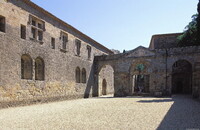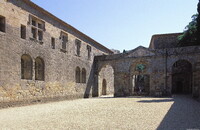| dc.coverage.spatial | Site: Fontfroide Abbey (Aude (department), Languedoc-Roussillon, France) | en_US |
| dc.coverage.temporal | ca. 1093-1780 (inclusive) | en_US |
| dc.creator | unknown (French) | en_US |
| dc.date | 1093-1780 | en_US |
| dc.date.accessioned | 2013-05-10T19:20:53Z | |
| dc.date.available | 2013-05-10T19:20:53Z | |
| dc.date.issued | 1093-1780 | en_US |
| dc.identifier | 216062 | en_US |
| dc.identifier.other | archrefid: 276 | en_US |
| dc.identifier.uri | http://hdl.handle.net/1721.3/123691 | |
| dc.description | Court of Honor (1777-1778), general view; The Cistercians deliberately sought out their desert wildernesses in places remote from all habitation, in enclosed valleys surrounded by wooded hills, with flat or sloping land close to a stream or river. Their aim was to work the land and make it cultivable, and names were chosen to indicate this transformation, for example at Fontfroide (Aude; refounded 1145). Although the Cistercians often avoided figure sculpture, in their later buildings they too took pride in graceful architectural forms and elegantly carved foliate capitals, as seen at Fontfroide Abbey (second half of the 13th century-early 14th). Source: Grove Art Online; http://www.groveart.com/ (accessed 2/8/2008) | en_US |
| dc.format.medium | stone | en_US |
| dc.rights | © Scott Gilchrist, Archivision, Inc. | en_US |
| dc.subject | architectural exteriors | en_US |
| dc.subject | Cistercians | en_US |
| dc.subject | Romanesque | en_US |
| dc.title | Fontfroide Abbey | en_US |
| dc.title.alternative | l'Abbaye Sainte-Marie de Fontfroide | en_US |
| dc.type | image | en_US |
| dc.rights.access | Licensed for educational and research use by the MIT community only | en_US |
| dc.identifier.vendorcode | 1A2-F-AF-A1 | en_US |
| vra.culturalContext | French | en_US |
| vra.technique | construction (assembling) carving (processes) | en_US |
| vra.worktype | monastery | en_US |
| vra.worktype | abbey church | en_US |
| dc.contributor.display | unknown (French) | en_US |



